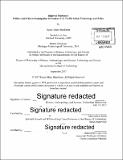| dc.contributor.advisor | Merritt Roe Smith. | en_US |
| dc.contributor.author | Blackburn, Renée Marie | en_US |
| dc.contributor.other | Massachusetts Institute of Technology. Program in Science, Technology and Society. | en_US |
| dc.coverage.spatial | n-us--- | en_US |
| dc.date.accessioned | 2018-03-02T22:20:09Z | |
| dc.date.available | 2018-03-02T22:20:09Z | |
| dc.date.copyright | 2017 | en_US |
| dc.date.issued | 2017 | en_US |
| dc.identifier.uri | http://hdl.handle.net/1721.1/113948 | |
| dc.description | Thesis: Ph. D. in History, Anthropology, and Science, Technology and Society (HASTS), Massachusetts Institute of Technology, Program in Science, Technology and Society, 2017. | en_US |
| dc.description | Cataloged from PDF version of thesis. | en_US |
| dc.description | Includes bibliographical references (pages 158-164). | en_US |
| dc.description.abstract | Modern U.S. traffic safety policy is largely guided by three overarching principles that have influenced governments, industry, and community and citizen activists since the 1940s. The terms, education, engineering, and enforcement, detailed in the Action Program for Traffic Safety were developed by engineers and U.S. federal government traffic safety experts in response to growing concerns around rising traffic fatalities. In these guidelines, and the iterations that developed from them, responsibility for traffic safety shifted between drivers, policy makers, and the automotive industry. My dissertation examines the evolution of traffic safety policy, specifically looking at solutions to reach zero fatalities, over multiple decades. The traffic safety experts, including the auto industry, federal government, and community activists, striving for zero fatalities have reshaped traffic infrastructure, automotive regulation, and consumer perceptions of risky behaviors in an attempt to solve a major public health issue. Broadly following four themes, infrastructure, institutions, technology, and behavior, each chapter highlights how these actors mitigated risks and defined safety in order to find solutions to highway fatalities. To safety-concerned government officials and industry leaders, central actors in the development of federal traffic safety policy, traffic safety encompassed engineering, education, enforcement, citizenship, humanitarian, and moral issues. On the other hand, to women's community and activist groups, like MADD, traffic safety's focus was the education of drivers and pedestrians, and the prevention of crashes through educational and public health approaches. However, to working class white males, government mandated safety was viewed as an infringement upon their freedom as individuals to choose how to be safe and how to define their level of safety, regardless of its effects on others. Through analysis of these narratives emerges a more complete picture of the public health, education, and social policy implications of twentieth century traffic safety, the role of citizen activism in traffic safety policy development at the local, state, and federal levels, and the ways in which the traffic safety solutions have shifted over time. | en_US |
| dc.description.statementofresponsibility | by Renée Marie Blackburn. | en_US |
| dc.format.extent | 164 pages | en_US |
| dc.language.iso | eng | en_US |
| dc.publisher | Massachusetts Institute of Technology | en_US |
| dc.rights | MIT theses are protected by copyright. They may be viewed, downloaded, or printed from this source but further reproduction or distribution in any format is prohibited without written permission. | en_US |
| dc.rights.uri | http://dspace.mit.edu/handle/1721.1/7582 | en_US |
| dc.subject | Program in Science, Technology and Society. | en_US |
| dc.title | Highway madness! : politics and citizen participation in postwar U.S. traffic safety technology and policy | en_US |
| dc.title.alternative | Politics and citizen participation in postwar U.S. traffic safety technology and policy | en_US |
| dc.type | Thesis | en_US |
| dc.description.degree | Ph. D. in History, Anthropology, and Science, Technology and Society (HASTS) | en_US |
| dc.contributor.department | Massachusetts Institute of Technology. Program in Science, Technology and Society | |
| dc.identifier.oclc | 1023434086 | en_US |
